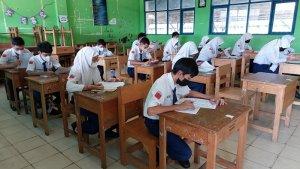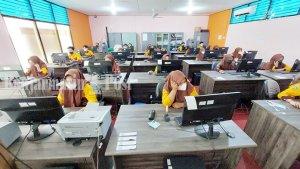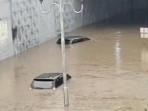Kurikulum Merdeka
Kunci Jawaban Bahasa Inggris Kelas 11 Halaman 69-71 Kurikulum Merdeka, Activity 7: Jigsaw Reading
Berikut kunci jawaban mata pelajaran Bahasa Inggris kelas 11 SMA/MA Kurikulum Merdeka, soal halaman 69-71.
Penulis: Kristin Juli Saputri | Editor: Mariana
BANJARMASINPOST.CO.ID - Berikut kunci jawaban mata pelajaran Bahasa Inggris kelas 11 SMA/MA Kurikulum Merdeka, soal halaman 69-71.
Pada halaman tersebut siswa kelas 11 diminta untuk mengerjakan soal Bahasa Inggris Unit 2 Love Your Environment, bagian Activity 7 Jigsaw Reading.
Soal kelas 11 SMA tersebut berada pada buku siswa Bahasa Inggris: English For Change Kelas XI SMA/MA Tahun 2022 karya penulis Puji Astuti, dan kawan-kawan.
Penerbit KEMENTERIAN PENDIDIKAN, KEBUDAYAAN, RISET, DAN TEKNOLOGI REPUBLIK INDONESIA.
Soal Bahasa Inggris kelas 11 SMA halaman 69-71 Kurikulum Merdeka di bawah ini dapat digunakan sebagai referensi pembelajaran siswa.
Baca juga: Jadwal Main Persib Bandung vs Persebaya Surabaya di Super League 2025: Big Match di Pekan ke-5
Baca juga: Update Percobaan Pembakaran di Baruh Jaya HSS, Warga Terus Berjaga Sampai Terduga Pelaku Ditemukan
Sebaiknya, siswa membaca dan menjawab soal terlebih dahulu untuk mengukur kemampuannya.
Siswa belajar dengan latihan soal dari contoh soal materi mata pelajaran Bahasa Inggris.
Siswa belajar dengan contoh soal latihan yang disiapkan dari ragam pertanyaan tersebut.
Selain untuk latihan soal Bahasa Inggris Kelas 11 SMA halaman 69-71 Kurikulum Merdeka bagi peserta didik, guru pun dapat memanfaatkannya sebagai referensi saat mengerjakan soal tersebut.
Kunci jawaban ini diharapkan dapat membantu orangtua dalam memandu proses belajar anak.
Inilah kunci jawaban soal Bahasa Inggris Kelas 11 SMA halaman 69-71 Kurikulum Merdeka soal Activity 7 Jigsaw Reading.
Activity 7
Work in a group of four. Read and comprehend the following text. Do Jigsaw Reading. You will do the activity in a group (home group), but each of you will focus on one paragraph and become the expert of the paragraph (expert group). Your teacher will give you further explanation on how to do Jigsaw Reading step by step.
Text 2
From the 1950s to 2015, the production of plastic products grew from virtually zero to about 350 million tons per year. This continuous increase has resulted in a cumulative total of 7.8 billion tons of plastic produced during this period, corresponding to more than one ton of plastic for each person alive as of the end of 2015.
Up until the 1980s, the idea of recycling plastic was unheard of. From the 1950s to the 1980s, plastics were either simply discarded into landills or incinerated. From the onset of plastic recycling in the 1980s to the present, the portion of plastic products that were recycled increased by an average of 0.7 persen per year.
As of the end of 2015, a staggering 55 persen of all plastic products end up in landills. This corresponds to about 4600 million tons of accumulated plastic waste over the years. About 700 million tons of plastic waste has been incinerated and about 2500 million tons remain in active use.
Of the entire volume of plastics that have been produced since the 1950s, only 500 million tons (roughly 6 % ) have been recycled. Of this portion, only 100 million tons remain in active use. The other 400 million tons have also ended up either getting discarded in landills or incinerated. Around 3 % of plastic waste produced annually ends up in oceans – or about 8 million tons by the end of 2015.
By use, packaging of goods constitutes the greatest volume of usage of plastic products at around 141 million tons. The next category has a volume of less than half – the building and construction industry at only 65 million tons. This emphasizes how heavy plastic production can be reduced by using non-plastic alternatives for product packaging. Looking at the plastic production rates per country, China leads the pack by a huge margin at around 60 million tons. The US comes in at second at 38 million tons.
Now state whether the statement is true or false, and show which part of the text supports the statement.
1. 8 million tons of plastics end up in the ocean.
2. Each person uses tons of plastic in their lives.
3. Plastic is mostly used in China.
Jawaban :
1. True (paragraph 4)
2. True (paragraph 1)
3. True (paragraph 5)
Disclaimer:
- Artikel ini hanya ditujukan kepada orang tua untuk memandu proses belajar anak.
- Sebelum melihat kunci jawaban, siswa harus terlebih dahulu menjawabnya sendiri, setelah itu gunakan artikel ini untuk mengoreksi hasil pekerjaan siswa.
(Banjarmasinpost.co.id/Kristin Juli Saputri)
| Kunci Jawaban Mapel IPA Kelas 9 SMP Halaman 180 Kurikulum Merdeka, Komuditas Pertanian |

|
|---|
| Kunci Jawaban Mapel IPA Kelas 7 SMP Kurikulum Merdeka, Aktivitas 7.7: Pengaruh Gerak Bumi |

|
|---|
| Kunci Jawaban Bahasa Inggris Kelas 11 SMA MA Halaman 63 Kurikulum Merdeka, Activity 1 Discussion |

|
|---|
| Kunci Jawaban Mapel IPS Kelas 7 SMP Kurikulum Merdeka, Makanan Tradisional Indonesia Halaman 18 |

|
|---|
| Kunci Jawaban Bahasa Inggris Kelas 12 Kurikulum Merdeka, Activity B.3: Work in Group Halaman 185 |

|
|---|
















Isi komentar sepenuhnya adalah tanggung jawab pengguna dan diatur dalam UU ITE.